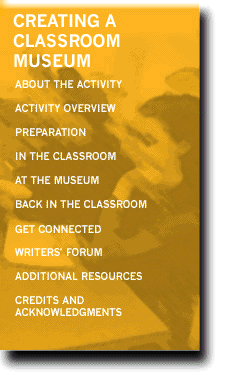

Preparation
![]() Assess the space available for a student exhibition.
Assess the space available for a student exhibition.
Your exhibition can be as big or small as you and your students want it
to be. If you prefer to keep it small, you could limit the exhibition to
an area inside the classroom itself or to a display case in the hallway.
A common area in the school will work for more elaborate exhibitions. You
might also want to consider having the students set up their exhibition
in a community center, library, or other area outside the school. If you
choose this option, you may need to make arrangements some time in advance.
![]() If students will be bringing objects from home, write a note explaining
the project to parents.
If students will be bringing objects from home, write a note explaining
the project to parents.
Tell parents that the students will be bringing objects from home. Be sure
to explain that you can't guarantee the objects' safety. (Students needn't
be limited to bringing objects from home; they can also make crafts or other
objects.)
![]() If possible, arrange to have a museum staff person available to
answer questions at the museum.
If possible, arrange to have a museum staff person available to
answer questions at the museum.
The students will be visiting the museum to get a feeling for how exhibitions
are put together and to get ideas for their own exhibition. A museum staff
person, docent, or other person who is very familiar with the exhibition
and how it was created can answer students' questions and shed light on
the process of planning an exhibition. Such a person can also discuss ways
objects and information are presented in exhibitions, such as in dioramas
(three-dimensional representations of particular scenes), case exhibits
(objects arranged inside a glass-fronted case), period rooms (actual or
recreated rooms using authentic objects from a certain time period), and
other types of displays.
![]() If possible, set up a behind-the-scenes tour.
If possible, set up a behind-the-scenes tour.
A tour of an exhibition in the process of being built can help students
see the steps that go into bringing an exhibition to life.
![]() Ask for an exhibition script and photos.
Ask for an exhibition script and photos.
Ask if the museum will lend you a copy of an exhibition script. Many museums
make scripts available upon request. (Since scripts can be hundreds of pages
long, you may want to ask for just a few pages.) A script will provide students
with examples of the way people create an exhibition's written material.
Also ask if you can borrow photos of the exhibition. Photos will be useful in helping students see how an exhibition's written material is arranged in relation to the objects on display.
![]() Develop a questionnaire for students to fill out while at the museum.
Develop a questionnaire for students to fill out while at the museum.
To help students think about how exhibitions impart information to visitors,
create a questionnaire that they can fill out while at the museum. Include
questions such as the following:
- Does the exhibition seem to be effective at presenting information to visitors? (Keep in mind that whether or not you personally like the subject matter isn't the point. What is important is whether or not the exhibition is successful at getting its information across.)
- What do you like or dislike about how the exhibition is presented?
- How are the objects positioned?
- Does lighting play a role in the exhibition?
- How are the objects protected from damage?
- What might be other ways to protect objects?

